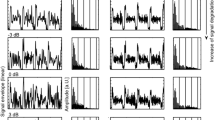Summary
Males of the grasshopper Chorthippus dorsatus produce songphrases which contain two differently structured elements — pulsed syllables in the first part (A) and ongoing noise in the second part (B). Females of Ch. dorsatus answer to artificial song models only if both elements A and B are present. Females strongly prefer song models in which the order of elements is A preceding B. Females discriminate between the two elements mainly by the existence of gaps within A-syllables. Pulses of 5–8 ms separated by gaps of 8–15 ms make most effective A-syllables, while syllable duration and syllable intervals are less critical parameters. Females respond to models which contain more than 3 A-syllables with high probability. Female model preferences lie well in the range of parameter values produced by singing males, except for B-parts which must be longer than those of any natural song to be most effective. In ancestors of Ch. dorsatus the two elements of the songs might have been directed towards females (part A) and males (part B).
Similar content being viewed by others
References
Butlin RK, Hewitt GM (1987) Genetic divergence in the Chorthippus parallelus species group (Orthoptera: Acrididae). Biol J Linn Soc 31:301–310
Elsner N (1974) Neuroethology of sound production in gomphocerine grasshoppers. I. Song patterns and stridulatory movements. J Comp Physiol 88:67–102
Faber A (1932) Die Lautäußerungen der Orthopteren II. (Untersuchungen über die biozönotischen, tierpsychologischen und vergleichend physiologischen Probleme der Orthopterenstridulation. Methodik der Bearbeitung und Auswertung von Stridulationsbeobachtungen. Einzeldarstellungen.) Z Morphol Oekol Tiere 26:4–93
Faber A (1953) Laut- und Gebärdensprache bei Insekten (Orthoptera). Mitt Staatl Mus Naturk Stuttgart, Stuttgart
Faber A (1957) Über den Aufbau von Gesangsformen in der Gattung Chorthippus und über phylogenetische Gemeinsamkeiten bei Stridulations- und anderen Bewegungsformen. Stuttg Beitr Naturkd 1:1–28
Faber A (1960) Form, Ableitung und Bedeutung von Stridulationsweisen im Verwandtschaftskreis um Chorthippus longicornis. Stuttg Beitr Naturkd 32:1–12
Fisher RA (1930) The genetical theory of natural selection. Oxford Univ Press, Oxford
Helversen D von (1972) Gesang des Männchens und Lautschema des Weibchens bei der Feldheuschrecke Chorthippus biguttulus L. J Comp Physiol 81:381–422
Helversen D von, Helversen O von (1983) Species recognition and acoustic localization in acridid grasshoppers: a behavioral approach. In: Huber F, Markl H (eds) Neuroethology and behavioral physiology. Springer Berlin Heidelberg New York, pp 95–107
Heiversen O von (1979): Angeborenes Erkennen akustischer Schlüsselreize. Verh Dtsch Zool Ges 1979:42–59
Heiversen O von (1986) Gesang und Balz bei Feldheuschrecken der Chorthippus albomarginatus-Gruppe (Orthoptera: Acrididae). Zool Jb Syst 113:319–342
Helversen O von, Elsner N (1977) The stridulatory movements of acridid grasshoppers recorded with an opto-electronic device. J Comp Physiol 122:53–64
Helversen O von, Helversen D von (1987) Innate receiver mechanisms in the acoustic communication of orthopteran insects. In: Guthrie DM (ed) Aims and methods in neuroethology. Manchester University Press, Manchester, pp 104–150
Huber F, Kleindienst H-U, Moore TE, Schildberger K, Weber T (1990) Acoustical communication in periodical cicadas: neuronal responses to songs of sympatric species. In: Gribakin FG, Wiese K, Popov AV (eds) Sensory systems and communication in arthropods. Birkhäuser, Basel, pp 217–228
Jacobs W (1953) Verhaltensbiologische Untersuchungen an Feldheuschrecken. Z Tierpsychol, Beiheft 1
Kirkpatrick M, Ryan MJ (1991) The evolution of mating preferences and the paradox of the lek. Nature 350:33–38
Komarova GF, Dubrovin NN (1973) A comparative study of the acoustic signals of two sibling species of grasshoppers Chorthippus dorsatus Zett and Ch. dichrous Ev. Zh Obshch Biol 34:571–574
Maynard-Smith JM (1991) Honest signalling: the Philip Sidney game. Anim Behav 42:1034–1035
Narins PM, Capranica RR (1976) Sexual differences in the auditory system of the tree frog Eleutherodactylus coqui. Science 192:378–380
Narins PM, Capranica RR (1978) Communicative significance of the two-note call of the tree frog Eleutherodactylus coqui. J Comp Physiol 127:1–9
Otte D (1972) Simple versus elaborate behavior in grasshoppers: an analysis of communication in the genus Syrbula. Behaviour 42:291–322
Pollack GS (1982) Sexual differences in cricket calling song recognition. J Comp Physiol 146:217–221
Pollack GS, Hoy RR (1979) Temporal pattern as a cue for species-specific calling song recognition in crickets. Science 204:429–432
Pollack GS, Hoy RR (1981) Phonotaxis to individual rhythmic components of a complex cricket calling song. J Comp Physiol 144:367–373
Ronacher B (1991) Contribution of abdominal commissures in the bilateral coordination of the hindlegs during stridulation in the grasshopper Chorthippus dorsatus. J Comp Physiol A 169:191–200
Ronacher B, Römer H (1985) Spike synchronization of tympanic receptor fibres in a grasshopper (Chorthippus biguttulus L. Acrididae): a possible mechanism for the detection of short gaps in model songs. J Comp Physiol A 157:631–642
Ronacher B, Stumpner A (1988) Filtering of behaviourally relevant temporal parameters of a grasshopper's song by an auditory interneurone. J Comp Physiol A 163:517–523
Ryan MJ, Drewes RC (1990) Vocal morphology of the Physalaemus pustulosus species group (Leptodactylidae): morphological response to sexual selection for complex calls. Biol J Linn Soc 40:37–52
Sachs L (1984) Angewandte Statistik. Springer, Berlin
Schmidt G, Schach G (1978) Biotopmäβige Verteilung, Vergesellschaftung und Stridulation der Saltatorien in der Umgebung des Neusiedler Sees. Zool Beitr 24:201–308
Stumpner A, Ronacher B, Heiversen O von (1991) Auditory interneurons in the metathoracic ganglion of the grasshopper Chorthippus biguttulus. II. Processing of temporal patterns of the song of the male. J Exp Biol 158:411–430
Vedenina VY (1990) Responses of sympatric acridid species to natural and artificial sound signals. In: Gribakin FG, Wiese K, Popov AV (eds) Sensory systems and communication in arthropods. Birkhäuser, Basel, pp 366–370
Vedenina VY, Zhantiev RD (1990) Recognition of acoustic signals in sympatric species of locusts. Zool Zh 69:36–45
Weih S (1951) Untersuchungen über das Wechselsingen (Anaphonie) und über das angeborene Lautschema einiger Feldheuschrecken. Z Tierpsychol 8:1–41
Author information
Authors and Affiliations
Rights and permissions
About this article
Cite this article
Stumpner, A., von Heiversen, O. Recognition of a two-element song in the grasshopper Chorthippus dorsatus (Orthoptera: Gomphocerinae). J Comp Physiol A 171, 405–412 (1992). https://doi.org/10.1007/BF00223970
Accepted:
Issue Date:
DOI: https://doi.org/10.1007/BF00223970




